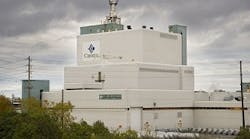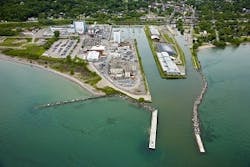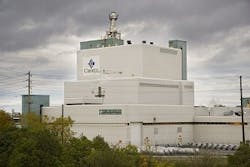Cameco supplies uranium processing services required to produce fuel for the generation of clean electricity by operators of nuclear reactors. The company currently supplies approximately 25% of the world’s conversion capacity. Cameco is one of two fuel manufacturers serving Canada’s reactor fleet and the largest Canadian supplier of components for Canada deuterium uranium (CANDU) reactors — Canadian-invented, pressurized heavy water reactors. Cameco’s products and services are used exclusively for the generation of clean electricity by nuclear power plants.
Cameco’s Port Hope Conversion Facility (PHCF) in Ontario converts refined uranium trioxide (UO3) received from its Blind River facility into new chemical forms needed for production of nuclear fuel. The facility uses two separate processes to produce uranium dioxide (UO2) and uranium hexafluoride (UF6). UO2 fuels CANDU heavy water reactors and UF6 undergoes further processing outside of Canada before being used in fuel for light water reactors, both of which are used in the production of clean electricity by nuclear power plants around the world. The facility is licensed to produce 12,500 tonnes of uranium per year in the form of UF6 and 2,800 tonnes of uranium per year in the form of UO2. The facility was not operating at full capacity when it embarked on the reliability journey. While market conditions kept the plant from operating at full capacity, habitual reactive practices kept the plant from achieving the lowest possible unit costs.
In addition to the processing plant, PHCF houses technology development labs, an analytical services lab, and a power house that provides all the utility services for the site. Approximately 350 people are full-time employees, and 40 part-time and contractor employees are at the unionized facility located in Port Hope.
The challenges
The PHCF is committed to ensuring a safe work environment for employees. Throughout the site, the company’s motto is visible and obvious in day-to-day operations, “There is no job that is so important that we cannot take the time to do it safely.” With a high correlation between reliability and safety, Cameco knew a stronger reliability effort would result in safer work conditions.
PHCF operations are regulated by the Canadian Nuclear Safety Commission (CNSC), as well as other government agencies. Adherence to environmental health and safety regulations is critical, and the plant is subject to random audits by the CNSC, which was also a key factor in deciding to implement a reliability initiative.
Several years prior to the initiative, the site implemented an enterprise resource planning (ERP) system from SAP, which included handling computerized maintenance management functions. Unfortunately the migration to SAP wasn’t considered successful for a number of reasons, including, but not limited to, inadequate training, lack of business process definition, inadequate configuration, incomplete transfer of legacy data, and poor change management. As a result, user adoption was low, and the system rendered only marginal results, causing the facility to run duplicate systems and develop manual workarounds to accomplish basic maintenance functions.
In order to achieve annual goals while keeping costs down and preserving environmental and employee safety, the team at Port Hope adopted reliability as the path to operational excellence.
The approach
The Port Hope leadership team partnered with Life Cycle Engineering (LCE) to conduct a site-wide assessment to identify trouble areas and gaps in performance. The assessment results identified that the PHCF was operating in a reactive fashion. Maintenance, operations, and engineering activities were driven by equipment failures instead of proactively planning and executing asset management plans to maximize output.
LCE and Port Hope established a plan to address four core areas:
- work management
- materials management
- reliability engineering
- operations improvement.
Focus teams were formed to target the core areas, and a comprehensive communications plan was developed as part of the change management activities. The LCE project team incorporated elements of the Prosci ADKAR change management methodology, along with Queen’s University’s change model for a customized, effective plan to address the people side of change. Using this approach, the team was able to determine if individuals had the necessary awareness, desire, knowledge, ability, and reinforcement to make the change. The structured change management strategy with visible and engaged leadership was a critical success factor in implementing reliability.
Reliability Excellence (Rx) best practices were employed including:
- project charters
- risk plan development and management
- partnership agreements
- vision letter concept to convey future state.
The results
LCE and the team at Port Hope worked together to establish 42 business processes covering the four core areas.
The materials management focus team saw a 300% increase in the use of materials reservations in SAP by site employees, greatly reducing time spent by employees walking to stores to acquire parts and materials. Kits were introduced in maintenance and now 20% of maintenance work orders have materials kitted and delivered in advance of work being executed.
The work management team introduced planning and scheduling tools and created discipline, and now all maintenance crews use a similar process. Year over year, more work is scheduled and completed, and today the site regularly boasts a weekly schedule compliance rate of 95%, with more than 90% of maintenance hours being scheduled weekly.
“We’re very proud of the improvements made by our team at Port Hope,” says Dale Clark, VP, fuel services division, Cameco. “LCE helped us transition from a reactive work environment to an organization that is committed to proactive operations and continual improvement. This leads to happier employees, a safer work environment, and a stronger bottom line financially.”
The reliability engineering team introduced criticality ranking, proactive reliability-centered maintenance analysis, corrective root cause analysis, and several metrics including mean time between failure and overall equipment effectiveness (OEE).
The operations improvement team realized significant improvements through the introduction of a production loss tracking system that leveraged the internal supervisory control and data acquisition (SCADA) system to capture occurrences of negative variances in key set points required to achieve target production. As a result, top production losses and causes are quick and easy to identify and correct; a visual control board displays hourly production target fulfillments or misses. OEE is also now tracked through the system, and an automated report on production rate and OEE is generated and sent to supervisors twice daily. As a result of the improvements, the site won the PEM Maintenance Award, “Best Use of Technology/Maintenance Innovation.”
Conclusions
Port Hope has made significant improvements in creating a “no surprises” work environment that is safe, healthy, and rewarding for its employees. It continues to develop and improve processes and business rules to further increase the savings and avoid costs associated with outages and inefficiencies in the sites. Using Reliability Excellence principles, the site was able to ensure it can sustain higher production levels and at lower costs.
With a committed leadership team, the facility continues down a path of continuous improvement with engaged employees that aspire for world-class performance in reliability.


